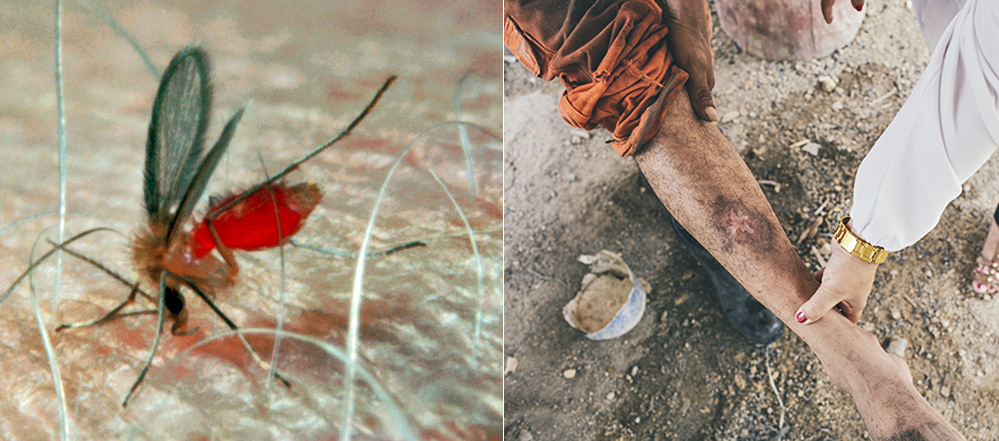Despite global commitments to eradicate neglected tropical diseases (NTDs), they continue to cause widespread death and suffering in vulnerable communities across the world. Visceral leishmaniasis (VL), also known as kala-azar, is a vector-borne NTD caused by Leishmania parasites. VL kills over 20,000 people a year and predominantly affects countries in the Indian subcontinent – 60% of global kala-azar cases occur in Nepal, India and Bangladesh.

(left) Sandfly on human skin. Photo: AFPMB. CC BY-NC-ND 2.0 | (right) Skin condition related to Kala-azar. Photo: PAHO. CC BY-NC 2.0
Researchers at icddr,b have been playing a central role in South Asian kala-azar elimination programmes, evaluating novel paradigms for VL control and revealing new dimensions of disease transmission.
Recent findings have shown that post-kala-azar dermal leishmaniasis (PKDL), a skin condition that develops after apparently successful treatment of VL, plays an important role in kala-azar transmission. It was previously controversial whether PKDL patients were contagious, but research from Dr Dinesh Mondal’s group at icddr,b has demonstrated that PKDL patients can transmit Leishmania parasites to insect vectors.
PKDL patients are reservoirs for parasites, but often remain untreated and contribute to inter-epidemic disease transmission. Incomplete cures can also result in cases of relapsed VL, creating another undetected pool of contagious individuals. These lingering parasite reservoirs impede kala-azar elimination efforts, and more effective diagnostic tools are needed to accurately monitor these patients.
A recent study published in PLOS ONE by Dr Mondal’s group, alongside collaborators from the Infectious Disease Research Institute in Seattle, reports the evaluation of a DNA-based diagnostic test for Leishmania parasites that can accurately detect infectious PKDL cases and monitor treatment response.
Diagnosis of VL in field settings often relies on detection of circulating blood antibodies against Leishmania parasites. A major disadvantage of these antibody-based diagnostic platforms is that antibodies continue to circulate in the blood even after the disease has been cured, making them ineffective at identifying contagious PKDL cases or for monitoring parasite clearance in response to drug treatments.
DNA-based diagnostics detect parasite DNA directly, compensating for the limitations of antibody-based diagnosis and allowing clinicians to identify those who are most likely to spread the disease.
Previous work from icddr,b has evaluated different DNA-based diagnostics for VL, but this is the first study to assess the utility of these approaches for diagnosing PKDL and monitoring treatment response.
The study compared two different molecular biology approaches – nested PCR and real-time PCR – to detect Leishmania parasites in different groups of human patients. The authors find that real-time PCR can identify cases of PKDL and relapsed VL more accurately than nested PCR, and that it can also be used to track parasite clearance in response to treatment.
Combining modern bioscience with a detailed understanding of the local context, Dr Mondal’s group has reshaped our understanding of kala-azar. By identifying a robust DNA-based diagnostic system for Leishmania detection across a wide range of contexts, this recent study could help in designing better strategies for VL elimination and ultimately save countless lives across the region.

